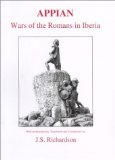|
Roman involvement in Iberia began during the Second Punic War. Hannibal's attack on the Iberian city of Saguntum gave Rome the pretext to declare war on Carthage. Rome's eventual victory gave them control of all of the Carthaginian territory in Iberia. Rome's subsequent expansion in the Iberian Peninsula was met by fierce resistance from the native Iberian tribes. It was not until the reign of Augustus that the entire peninsula was brought under Roman Rule.
The Romans called Iberia Hispania, though this name is likely Phoenician in origin. During the Roman Republic, Rome divided Hispania into 2 provinces: 'Hispania Citerior' (Near Spain) and 'Hispania Ulterior' (Far Spain) (see map 1 - 56 BC). During the reign of Augustus, the last tribal areas of Hispania were conquered and Hispania was redivided into 3 provinces: Lusitania in the West, Baetica in the South, and Tarraconensis in the rest of the Peninsula and the Balearic Islands. (see map 2 - 10 AD) Hispania rose to become one of the most important regions in the Roman Empire. Many of the peninsula's population were admitted into the Roman aristocratic class and they participated in governing Hispania and the Roman empire. The latifundia (sing., latifundium), large estates controlled by the aristocracy, were superimposed on the existing Iberian landholding system. The Romans improved existing cities, such as Lisbon (Olissipo) and Tarragona (Tarraco), established Zaragoza (Caesaraugusta), Mérida (Augusta Emerita), and Valencia (Valentia), and provided amenities throughout the empire. The peninsula's economy expanded under Roman tutelage. Hispania served as a granary and a major source of metals for the Roman market, and its harbors exported gold, tin, silver, lead, wool, wheat, olive oil, wine, fish, and garum . Agricultural production increased with the introduction of irrigation projects, some of which remain in use today. The romanized Iberian populations and the Iberian-born descendants of Roman soldiers and colonists - had all achieved the status of full Roman citizenship by the end of the 1st century. The emperors Trajan (r. 98-117), Hadrian (r. 117-38), and Marcus Aurelius (r. 161-80) were born in Hispania. During the late Roman period, the Empire was constantly under both internal and external threats. In order to reduce the power of provincial governors, the Emperor Diocletian drastically reduced the size of the larger Roman provinces, one of these was the formidable Hispania Tarraconensis, which was subdivided into 4 smaller provinces: Gallaecia in the Northwest, Tarrconense in the Northeast, Cartaginensis in the central and southern portions, and Hispania Balearica in the Balearic Islands. (see map 3 - 285 AD) Roman rule in Hispania ended during the collapse of the Western Roman Empire to the invasion of various Germanic tribes. The Visigoths were the tribe that came to dominate Hispania. Think you know all about Ancient Iberia? Test yourself on our quick online quiz |





